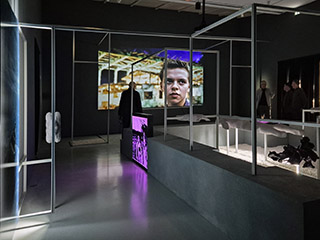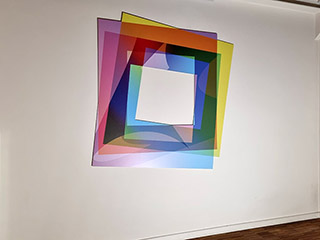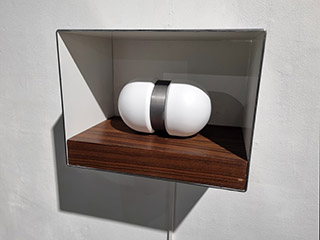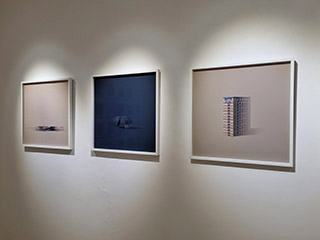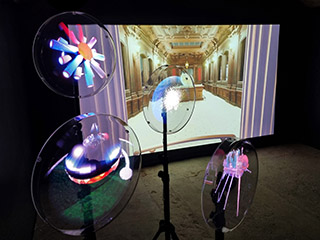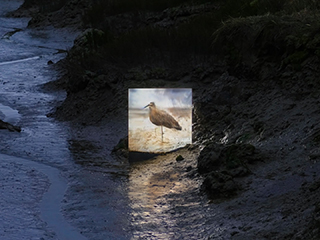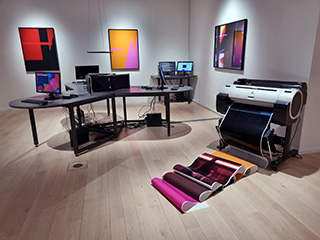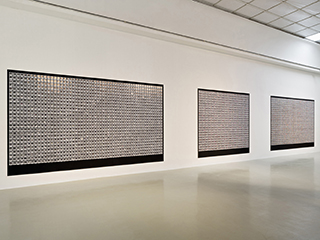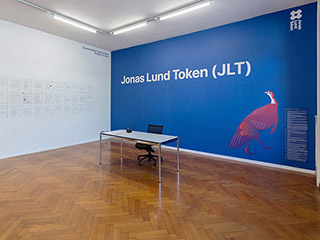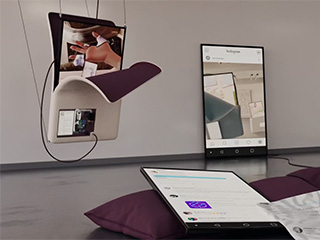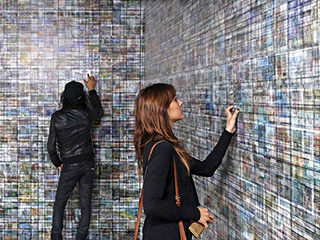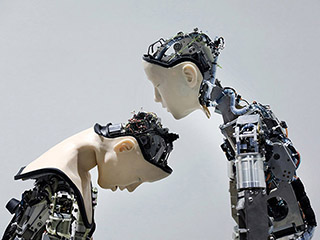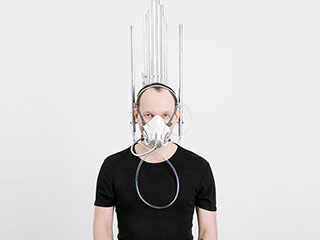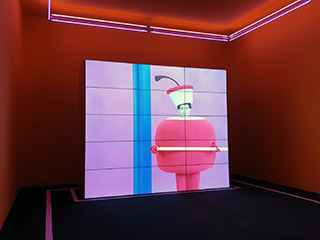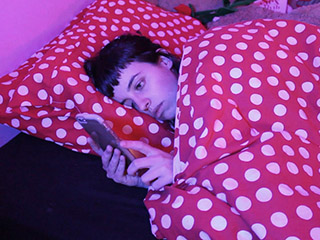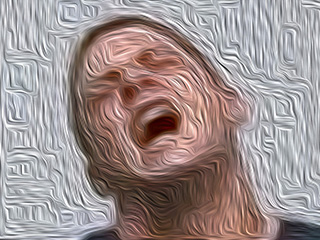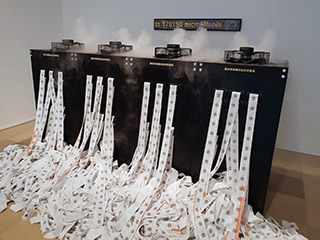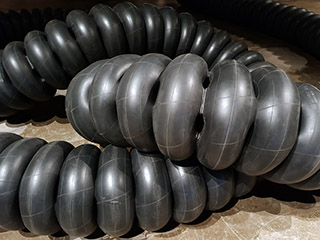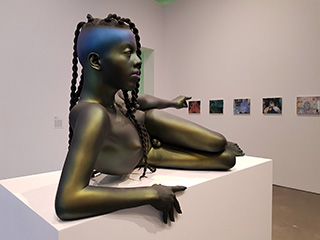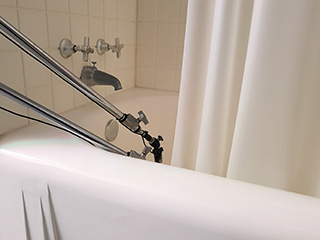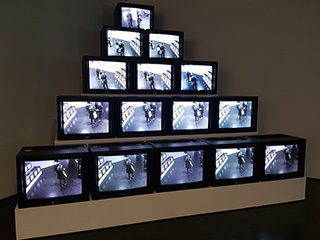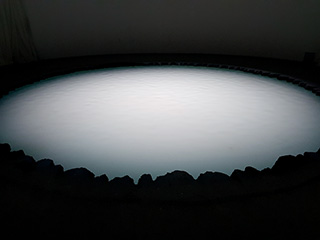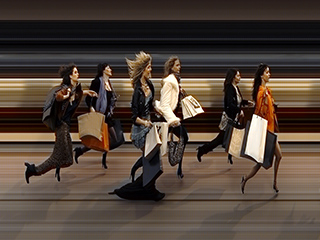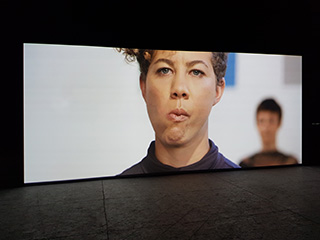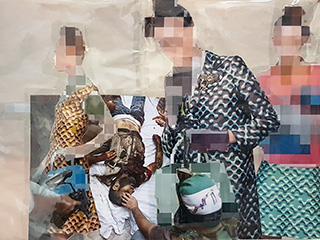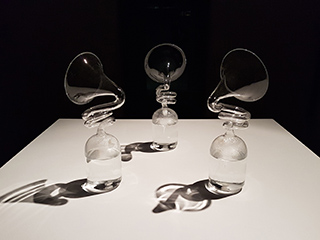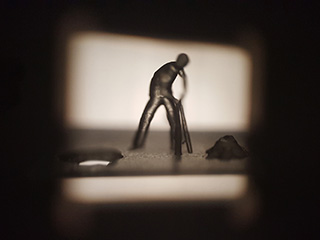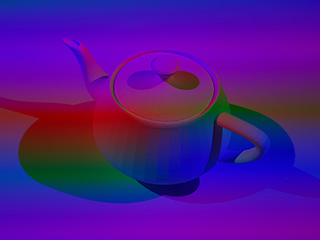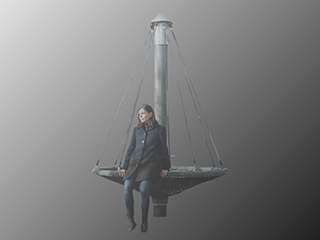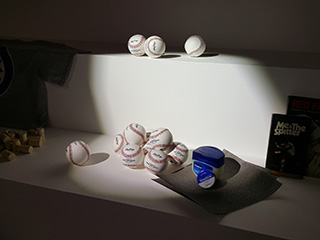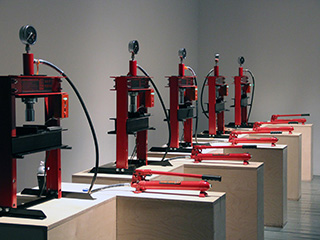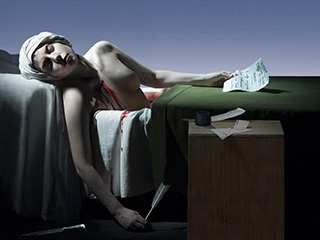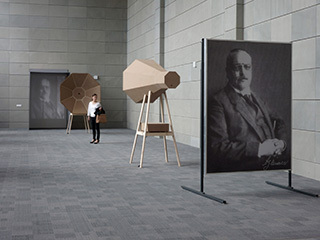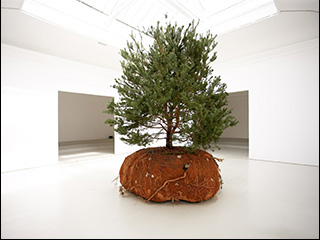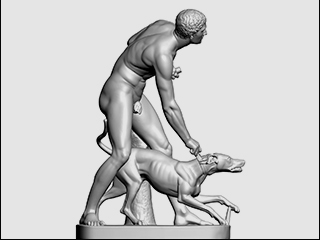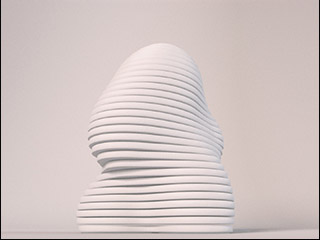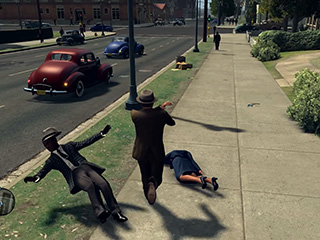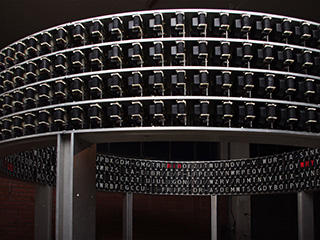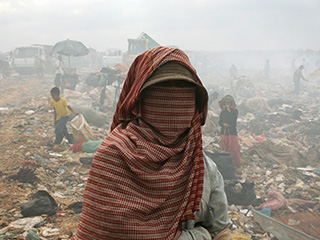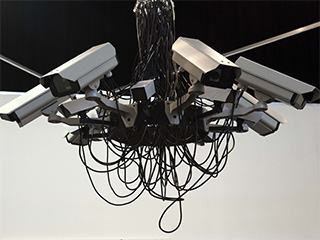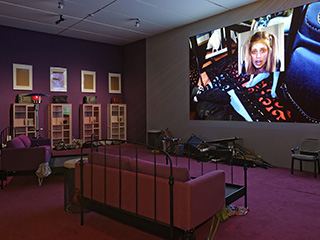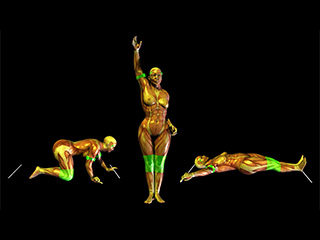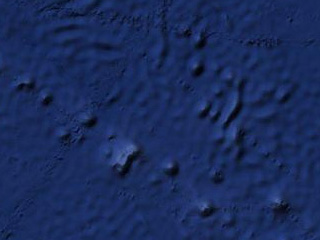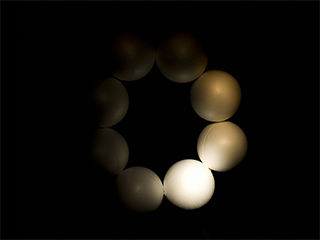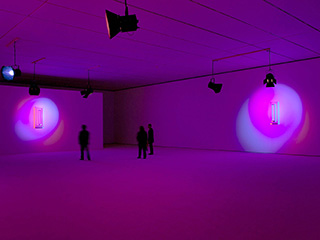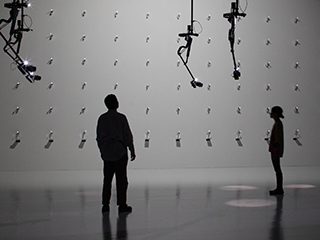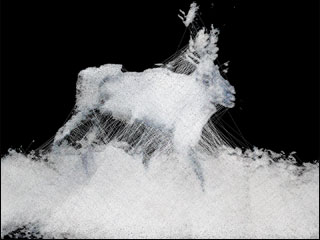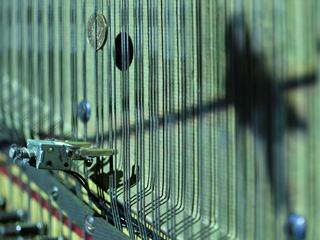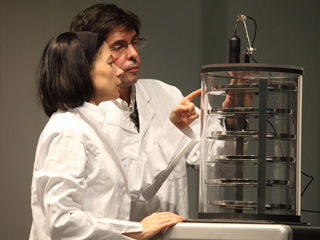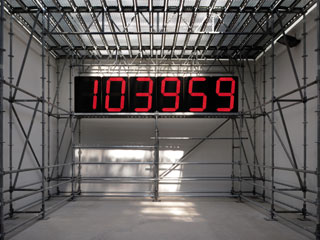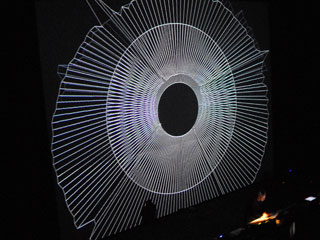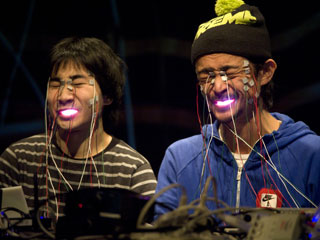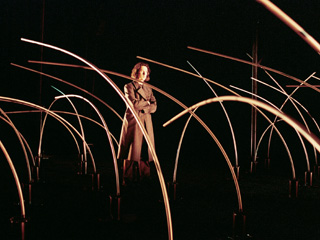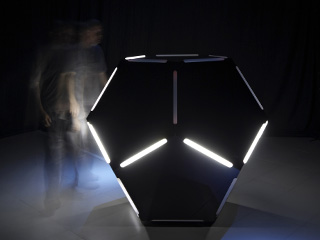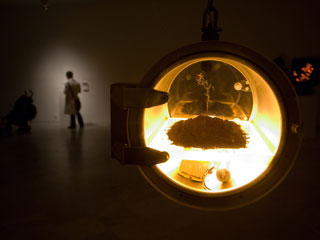N E W M E D I A A R T . E U
Articles
> Paris Photo
> Art, technology and AI
> Immersive Art
> Chroniques Biennial
> 7th Elektra Biennial
> 60th Venice Biennial
> Endless Variations
> Multitude & Singularity
> Another perspective
> The Fusion of Possibilities
> Persistence & Exploration
> Image 3.0
> BioMedia
> 59th Venice Biennale
> Decision Making
> Intelligence in art
> Ars Electronica 2021
> Art & NFT
> Metamorphosis
> An atypical year
> Real Feelings
> Signal - Espace(s) Réciproque(s)
> On Combinations at Work
> Human Learning
> Attitudes and forms by women
> Ars Electronica 2019
> 58th Venice Biennale
> Art, Technology and Trends
> Art in Brussels
> Plurality Of Digital Practices
> The Chroniques biennial
> Ars Electronica 2018
> Montreal BIAN 2018
> Art In The Age Of The Internet
> Art Brussels 2018
> At ZKM in Karlsruhe
> Lyon Biennale 2017
> Ars Electronica 2017
> Digital Media at Fresnoy
> Art Basel 2017
> 57th Venice Biennial
> Art Brussels 2017
> Ars Electronica, bits and atoms
> The BIAN Montreal: Automata
> Japan, art and innovation
> Electronic Superhighway
> Lyon Biennale 2015
> Ars Electronica 2015
> Art Basel 2015
> The WRO Biennale
> The 56th Venice Biennale
> TodaysArt, The Hague, 2014
> Ars Electronica 2014
> Basel - Digital in Art
> The BIAN Montreal: Physical/ity
> Berlin, festivals and galleries
> Unpainted Munich
> Lyon biennial and then
> Ars Electronica, Total Recall
> The 55th Venice Biennale
> The Elektra Festival of Montreal
> Digital practices of contemporary art
> Berlin, arts technologies and events
> Sound Art @ ZKM, MAC & 104
> Ars Electronica 2012
> Panorama, the fourteenth
> International Digital Arts Biennial
> ZKM, Transmediale, Ikeda and Bartholl
> The Gaîté Lyrique - a year already
> TodaysArt, Almost Cinema and STRP
> The Ars Electronica Festival in Linz
> 54th Venice Biennial
> Elektra, Montreal, 2011
> Pixelache, Helsinki, 2011
> Transmediale, Berlin, 2011
> The STRP festival of Eindhoven
> Ars Electronica repairs the world
> Festivals in the Île-de-France
> Trends in Art Today
> Emerging artistic practices
> The Angel of History
> The Lyon Biennial
> Ars Electronica, Human Nature
> The Venice Biennial
> Nemo & Co
> From Karlsruhe to Berlin
> Media Art in London
> Youniverse, the Seville Biennial
> Ars Electronica, a new cultural economy
> Social Networks and Sonic Practices
> Skin, Media and Interfaces
> Sparks, Pixels and Festivals
> Digital Art in Belgium
> Image Territories, The Fresnoy
> Ars Electronica, goodbye privacy
> Digital Art in Montreal
> Art, technology and AI
> Immersive Art
> Chroniques Biennial
> 7th Elektra Biennial
> 60th Venice Biennial
> Endless Variations
> Multitude & Singularity
> Another perspective
> The Fusion of Possibilities
> Persistence & Exploration
> Image 3.0
> BioMedia
> 59th Venice Biennale
> Decision Making
> Intelligence in art
> Ars Electronica 2021
> Art & NFT
> Metamorphosis
> An atypical year
> Real Feelings
> Signal - Espace(s) Réciproque(s)
> On Combinations at Work
> Human Learning
> Attitudes and forms by women
> Ars Electronica 2019
> 58th Venice Biennale
> Art, Technology and Trends
> Art in Brussels
> Plurality Of Digital Practices
> The Chroniques biennial
> Ars Electronica 2018
> Montreal BIAN 2018
> Art In The Age Of The Internet
> Art Brussels 2018
> At ZKM in Karlsruhe
> Lyon Biennale 2017
> Ars Electronica 2017
> Digital Media at Fresnoy
> Art Basel 2017
> 57th Venice Biennial
> Art Brussels 2017
> Ars Electronica, bits and atoms
> The BIAN Montreal: Automata
> Japan, art and innovation
> Electronic Superhighway
> Lyon Biennale 2015
> Ars Electronica 2015
> Art Basel 2015
> The WRO Biennale
> The 56th Venice Biennale
> TodaysArt, The Hague, 2014
> Ars Electronica 2014
> Basel - Digital in Art
> The BIAN Montreal: Physical/ity
> Berlin, festivals and galleries
> Unpainted Munich
> Lyon biennial and then
> Ars Electronica, Total Recall
> The 55th Venice Biennale
> The Elektra Festival of Montreal
> Digital practices of contemporary art
> Berlin, arts technologies and events
> Sound Art @ ZKM, MAC & 104
> Ars Electronica 2012
> Panorama, the fourteenth
> International Digital Arts Biennial
> ZKM, Transmediale, Ikeda and Bartholl
> The Gaîté Lyrique - a year already
> TodaysArt, Almost Cinema and STRP
> The Ars Electronica Festival in Linz
> 54th Venice Biennial
> Elektra, Montreal, 2011
> Pixelache, Helsinki, 2011
> Transmediale, Berlin, 2011
> The STRP festival of Eindhoven
> Ars Electronica repairs the world
> Festivals in the Île-de-France
> Trends in Art Today
> Emerging artistic practices
> The Angel of History
> The Lyon Biennial
> Ars Electronica, Human Nature
> The Venice Biennial
> Nemo & Co
> From Karlsruhe to Berlin
> Media Art in London
> Youniverse, the Seville Biennial
> Ars Electronica, a new cultural economy
> Social Networks and Sonic Practices
> Skin, Media and Interfaces
> Sparks, Pixels and Festivals
> Digital Art in Belgium
> Image Territories, The Fresnoy
> Ars Electronica, goodbye privacy
> Digital Art in Montreal
> >
For the third consecutive year, Paris Photo is dedicating a section to digital technology in photography and art more generally. Once again, this year, Nina Roehrs is curating the exhibition, coordinating the contributions of thirteen galleries.
[ Brodbeck & de Barbuat, Study after Man Ray,
Black and White, 1926-2022. ]
Black and White, 1926-2022. ]
Immersive art is a trend that describes the audience's experience rather than the nature of the artwork itself. It has attracted the attention of institutions such as the Guggenheim Museum in Bilbao and the MoMA in New York, as well as dedicated centers such as Superblue in Miami.
[ Yayoi Kusama, Infinity Mirrored Room
- Let's survive forever, 2017. ]
- Let's survive forever, 2017. ]
Montreal's seventh Elektra International Digital Art Biennial returns to Arsenal Contemporary Art, where curator Alain Thibault has brought together the creations of some thirty artists on the theme of Illusion.
[ Navid Navab, Organism & Excitable Chaos, 2024,
en collaboration avec Garnet Willis. ]
en collaboration avec Garnet Willis. ]
The world accelerated as one industrial revolution after another produced societal and aesthetic changes. It was in the 19th century that the serial treatment of subjects became widespread in painting, as if to better grasp every aspect of them. In an age of unbridled use of artificial intelligence…
[ Nicolas Sassoon,
The Prophets, 2019. ]
The Prophets, 2019. ]
Two notions that gained currency with the start of the new millennium are the multitude – the crowd made up of people connected with each other via networks – and technological singularity – the idea that machines will eventually become superior to human beings.
[ Jeppe Hein, 360°
Illusion IV, 2008. ]
Illusion IV, 2008. ]
With the successive arrival of personal computers and the Internet, artists have begun to deconstruct systems of representation, thus continuing what the cubist and abstract painters of the beginning of the last century had initiated. But haven't we all been affected by this change in perspective?
[ Artie Vierkant, Image objects
Friday 7 june 2013 4.23pm, 2013. ]
Friday 7 june 2013 4.23pm, 2013. ]
Yesterday's possibilities are today's realities that we are constantly merging to make them even better. Over the last sixty years, many artists with a strong affinity for technology of their time have anticipated our environments or uses with their creations.
[ Michele Spanghero,
Double Negative, 2020. ]
Double Negative, 2020. ]
This year, the art [ ] collector prize founded by Evelyne and Jacques Deret was awarded to Thibault Brunet. This gave rise to an exhibition entitled Mondes Persistants & Pratiques Exploratoires at 24 Beaubourg. An opportunity to penetrate the aesthetic of this artist oscillating between the pictorial and the photographic.
[ Mondes Persistants & Pratiques Exploratoires, 24Beaubourg, 2022. ]
The IMAGE 3.0 exhibition at the Cellier in Reims, organised by the curators Quentin Bajac and Pascal Beausse, is the result of a joint photographic commission from the Centre national des arts plastiques and the Jeu de Paume. The practices brought together here question representation as much as gaze in this digital age.
[ Donatien Auber, La Cybernétique,
le vivant et la ville, 2021. ]
le vivant et la ville, 2021. ]
It is difficult to have a clear-cut opinion of the Biennale because the artistic proposal in Venice is so abundant. In the national pavilions, from the gardens to the Arsenale halls, to the city's palaces and other collateral events, thousands of artworks are on display.
[ Elisa Giardina Papa, “U Scantu”:
A Disorderly Tale, 2022. ]
A Disorderly Tale, 2022. ]
Decisions are the result of complex cognitive processes. Considering them collectively, as they involve our shared futures, makes them nothing less than crucial. But, more and more often, we include machines in such processes through decisional algorithms.
[ Adam Basanta, All We'd Ever Need
Is One Another (Trio), 2019. ]
Is One Another (Trio), 2019. ]
Digital artistic practices are decidedly plural and their trends follow one another at the pace of technological innovations, currently with a strong enthusiasm for artificial intelligence and its “neural networks”.
[ Anna Ridler, Myriad (Tulips), 2018,
source Raimund Zakowski. ]
source Raimund Zakowski. ]
While there has been technology in art since the late 1960s and artworks on the Internet since the mid-1990s, it was not until 2021 that the art market took notice following a few record NFT sales. Or how digital artists approach this new territory.
[ Jonas Lund , "Smart Contracts",
Jonas Lund Tokens sales office, 2019,. ]
Jonas Lund Tokens sales office, 2019,. ]
The hybrid exhibition Metamorphosis Vol.2 at the Hyundai Motorstudio in Seoul is particularly well documented. To such an extent that it can be experienced via a virtual 3D tour, i.e. without having to travel to Korea. This is very much appreciated in these times of strict travel constraints.
[ Metamorphosis Vol.2,
Seoul 2020. ]
Seoul 2020. ]
The European itinerant biennial Manifesta passes through Marseille for its 13th edition. In its wake, many artistic events are taking place, such as the exhibition Signal - Espace(s) Réciproque(s), which is being held at the Friche la Belle de Mai from a proposal by the Centre Wallonie-BruxellesMai.
[ Claire Williams, Zoryas,
electronic activity of the sun, 2019. ]
electronic activity of the sun, 2019. ]
Artworks by the French artist Pascal Dombis are the results of myriads of lines, texts and images combined together, and the variability inherent in the different elements combined is taken care of by the computation of algorithms that he controls through machines.
[ Pascal Dombis,
Mixed_Grill(e), 2015. ]
Mixed_Grill(e), 2015. ]
We have taught everything to machines and continue to supply them so that they pursue the 'desire' for autonomy we would like to grant them. Isn’t it time that we started thinking that we, too, learn from them by observing their specificities or qualities? Answer at the Canadian Cultural Centre in Paris.
[ Justine Emard, Soul Shift, 2018
(Ishiguro lab & Ikegami Lab). ]
(Ishiguro lab & Ikegami Lab). ]
The exhibition of 1969, When attitudes become form, curated by Harald Szeemann, brought together many artists but very few women. Mentalities are evolving because 50 years later the Haro sur les héros exhibition of the Wallonie-Bruxelles Centre on attitudes and forms presents only women artists.
[ Cinzia Campolese, Frame of Reference, 2018 (photo Perte de signal). ]
The Ars Electronica Festival in Linz, Austria, was created in 1979. With this time frame in mind, Christine Schöpf and Gerfried Stocker, the two artistic directors of this year’s festival, have taken stock of the societal changes that digital technology is provoking and that art is amplifying. Because it is also by observing the past that we project ourselves into the future.
[ Dmitry Morozov / ::vtol::, Last Breath, 2019
(Source Anna Kortyukova) ]
(Source Anna Kortyukova) ]
The main theme of this 58th Venice Biennale was entrusted to the American curator Ralph Rugoff. Its title, May you live in interesting times, appears to us as an injunction to appreciate the world as it is in observing it. Then the question of points of view arises!
[ Alex Da Corte, Rubber Pencil Devil, 2019. ]
The major art schools participate in initiating trends. The Art and Technology Studies department of the SAIC is a leading example. By analyzing significant works by several artists who have carried out studies there, we can begin to understand the range and impact of the practices under consideration and to affirm the excellence of its teaching.
[ John Gerrard, Western Flag (Spindletop, Texas), 2017. ]
Art Brussels is one of the most important international spring fairs. It is an opportunity for discovering the new Kanal Centre Pompidou and for venturing into places that, like Senne, Société and IMAL, are participating in the artistic expansion of Brussels.
[ Molly Soda, All I have is my phone, 2016. ]
Never has a technique or technology so intensified artistic practices in a way that is as dazzling as it is long-lasting, beginning with the fields of sound and image, which have been revolutionized profoundly; to the point that there is not a single work today without some digital component, as small as that may be.
[ Émilie Brout & Maxime Marion, Lightning Ride, 2017,
vidéo UHD, 7'40'', courtesy Galerie 22,48 m². ]
vidéo UHD, 7'40'', courtesy Galerie 22,48 m². ]
The beginning of September, for those who scrutinize societal evolutions that researchers or artists reveal in the analysis or the use of emerging technology occurs in Linz at Ars Electronica. This year, the Austrian festival focuses on error in order to consider an Art of Imperfection.
[ LarbitsSisters, BitSoil Popup Tax &
Hack Campaign, 2018. ]
Hack Campaign, 2018. ]
Eva Respini, accompanied by Jeffrey De Blois, is the curator of the “Art In The Age Of The Internet, 1989 To Today” exhibition, at the Boston ICA, where the works are based on five sections questioning the relations that artists have with the Internet, to interrogate societal mutations.
[ Frank Benson, “Juliana”,
2014-2015. ]
2014-2015. ]
Art Brussels, celebrating its 50th anniversary this year, acts as a catalyst as it is followed by institutions, galleries and collectors who take advantage of the opportunity to organize leading events there. In April, exhibitions took place at the same time, from the Wiels to the Centrale or the Raffinerie, or even the Société d’électricité or Senne.
[ Paul Pfeiffer, “Self portrait
as a fountain”, 2000. ]
as a fountain”, 2000. ]
Exhibitions follow one another at the Zentrum für Kunst und Medientechnologie under the goodwill of Peter Weibel, its director, who is collaborating with intern or extern curators to set up exhibitions, such as Radical Software, Datumsoria, Open Codes and Hybrid Layers.
[ Frank Gillette, “Track/
Trace”, 1972/2017. ]
Trace”, 1972/2017. ]
This year, the curation of the 14th Lyon Biennale, cofounded in 1991 by Thierry Raspail (director of the Museum of Contemporary Art of Lyon) was handed over to the art historian and director of the Centre Pompidou-Metz Emma Lavigne. Second episode of a trilogy articulated around the “modern” word, it is dedicated to the “Floating Worlds”.
[ Doug Aitken, “Sonic
Fountain II”,2013-2017. ]
Fountain II”,2013-2017. ]
Le Fresnoy, France's international institution for the teaching, production and promotion of new media art, is a site for the digital contamination of images and sound. This is evident in the work of ten artists, some students and other teachers, who have been part of this school over the last decade.
[ Sébastien Hildebrand,
“Run Baby Run” , 2010. ]
“Run Baby Run” , 2010. ]
Mid-June, the principal players of the contemporary art world gather for Basel's fair and other events in as well as off or even out. Pulling out of the market allows us to walk around a few institutions such as the Haus der Elektronischen Künste.
[ Doug Aitken, “Mirage”, 2017,
courtesy 303 Gallery, New York. ]
courtesy 303 Gallery, New York. ]
The 57th Venice Biennial is running until November. With, this year, a French principal curator, Christine Macel, and Golden Lions for Anne Imhof at the German Pavilion of the Giardini and Franz Erhard Walther at the Arsenale Corderie. Among the multiple exhibitions, here is a selection.
[ Julien Prévieux, “What Shall We Do Next?
(Sequence #2)”, 2014. ]
(Sequence #2)”, 2014. ]
Each year, in April, Brussels hosts the many actors of the art world during its fair, which is one of the most important internationally. It is also the opportunity to explore its contemporary art centers, such as the Wiels or Centrale, as well as its exhibition platforms, including Société, and its art offices like White Circle.
[ Thomas Hirschhorn, “Pixel-Collage”, 2015,
courtesy Chantal Crousel. ]
courtesy Chantal Crousel. ]
The Ars Electronica festival in Linz, Austria has already enjoyed a long history and is once again open this September. For this 2016 edition, Artistic Director Gerfried Stocker has organized it around what he considers a sort of alchemy of our time, interconnecting bits to atoms, and hence the immaterial to the material.
[ Nelo Akamatsu,
“Chozumaki ”, 2016. ]
“Chozumaki ”, 2016. ]
For its third edition, the International Biennial of Digital Art of Montreal set up at the Arsenal. Initiated by Alain Thibault, who is also the Artistic Director, it again this year brings together a plethora of events prompting us to reconsider an art ‘made by machines’ and / or ‘for machines’ with its theme: Automata.
[ Julien Maire,
“Man at Work”, 2014. ]
“Man at Work”, 2014. ]
This year, the Japanese House of Culture in Paris has initiated a series of exhibitions titled Transphere. Named Fertile Landscapes, the first is dedicated to artists Daito Manabe and Motoi Ishibashi who often work together in the company they run, Rhizomatiks Research.
[ Daito Manabe
& Motoi Ishibashi,
“Rate-Shadow”,
2016. ]
& Motoi Ishibashi,
“Rate-Shadow”,
2016. ]
Electronic Superhighway is the name of a historical video installation by Nam June Paik. But it is also the title of a contemporary exhibition organised by Omar Kholeif at Whitechapel in London. An inventory of rare relevance that goes back in time to the evocation of Experiments in Art and Technology whose mission, from 1966, was to get artists and engineers to work together.
[ Olia Lialina,
“Best Effort Network”,
2015. ]
“Best Effort Network”,
2015. ]
The artistic director, Thierry Raspail, entrusted the role of curator for this Lyon Biennale to Ralph Rugoff. The title, Modern Life that emerged from their exchanges for this thirteenth edition, brings together a number of venues including the Contemporary Art Museum, the Confluences and the Sucrière, where one finds, as every year, exceptional works.
[ Julien Prévieux,
“Petite anthologie
de la triche”, 2015. ]
“Petite anthologie
de la triche”, 2015. ]
ARS ELECTRONICA 2015
Returning from Art Basel, depending of one’s fortune, one comes back with works of art or figures, while others retain a reading of the trends in contemporary art. All practices, or almost all, are represented. So in order not to be too dispersed it is best to focus on a theme, support, or a medium, such as moving images for example.
[ Robert Wilson “Lady Gaga:
The Death of Marat”, 2013. ]
The Death of Marat”, 2013. ]
Initiated in 1989 and dedicated to media art, the WRO Biennial is one of the cultural consequences of the fall of the Berlin Wall. A strong French representation may be noticed this year due to the fact that Klio Krajewska, associated curator of the event, lives and works between Paris and Wroclaw in Poland.
[ Bertrand Planes & Arnauld Colcomb,
“Modulateur-Démodulateur”, 2014. ]
“Modulateur-Démodulateur”, 2014. ]
The current president of the Venice Biennale, Paolo Baratta asked Okwui Enwezor to orchestrate the 2015 edition with an exhibition between the Arsenal and the Giardini, entitled "All the World’s Futures." A total of 89 countries were represented through their national pavilions, without omitting the 44 collateral events scattered throughout the city.
[ Céleste Boursier-Mougenot, “Révolutions”, 2015,
Courtesy Xippas Gallery, Source Laurent Lecat. ]
Courtesy Xippas Gallery, Source Laurent Lecat. ]
TodaysArt festival dedicated to visual arts, audio-visual performances, and electronic cultures founded by Olof van Winden is celebrating its tenth anniversary this year. After residing in the city centre of The Hague for nine years it has now moved closer to the edge of the North Sea, notably with an exhibition entitled "The Fluidity Aspect".
[ Oliver Laric,
“Lincoln 3D Scans”, 2013. ]
“Lincoln 3D Scans”, 2013. ]
The artistic directors of the Ars Electronica Festival, Christine Schöpf and Gerfried Stocker opted this year for change, by investing Linz differently and in terms of theme. Regarding art as a catalyst, they invite us again to reconsider the world, this time to better foresee the future.
[ Universal Everything,
“Walking City”, 2014. ]
“Walking City”, 2014. ]
Each year artists, gallery owners, collectors, curators and critics from around the world gather in Basel on the occasion of the contemporary art fairs. The most important of them undoubtedly being Art Basel, there were however a few satellite fairs such as Design Miami, Liste, Scope, The Solo Show and Volta worth seeing.
[ Harun Farocki, “ Parallele”, 2012-2014,
courtesy Thaddaeus Ropac ]
courtesy Thaddaeus Ropac ]
In winter in Berlin, two complementary events share the same public: Transmediale is dedicated to digital arts and cultures and the CTM Festival focuses on sonic practices and electronic music, not to mention partner events and other galleries in the centre of Berlin worth visiting.
[ LAb[au], “Signal to
noise”, 2012 ]
noise”, 2012 ]
In winter in Berlin, two complementary events share the same public: Transmediale is dedicated to digital arts and cultures and the CTM Festival focuses on sonic practices and electronic music, not to mention partner events and other galleries in the centre of Berlin worth visiting.
[ John Einar Sandvand,
“Cambodia Tales”, 2009 ]
“Cambodia Tales”, 2009 ]
Unpainted, directed by Annette Doms, is the first German fair dedicated to media art -including international galleries supporting artists using the technologies of their time.
[ Addie Wagenknecht, Asymmetric Love,
2013, Courtesy XPO Gallery ]
2013, Courtesy XPO Gallery ]
The Artistic Director of the Lyon Biennial, Thierry Raspail, entrusted the organisation of this twelfth edition to the curator Gunnar B. Kvaran. Extending across multiple sites, such as the MAC, La Sucrerie, and fairs and exhibitions, the Docks Art Fair and the Rendezvous IAC in Villeurbanne also participate in the event.
[ Lizzie Fitch & Ryan Trecartin,
“The Re'Search", 2010, © Blaise Adilon ]
“The Re'Search", 2010, © Blaise Adilon ]
Gerfried Stocker and Christine Schöpf, who artistically co-directed the Ars Electronica festival this year opted for a title borrowed from director Paul Verhoeven: Total Recall. Memory, its storage or loss, is at the center of the issues discussed during the symposium. But it is also the common thread among the works in the exhibition at the Brucknerhaus.
[ Daniel Rozin, “Angles Mirror”, 2013,
Courtesy Bitforms Gallery ]
Courtesy Bitforms Gallery ]
Though the historical pavilions of the Venice Biennale are concentrated around the Giardini, some countries take over the palaces of the City and it is Massimiliano Gioni who is responsible for the exhibition at the Arsenal. The Venice Biennale is also nearly fifty collateral events and two “Lions”: the gold was awarded to Tino Sehgal and the silver to Camille Henrot.
[ ORLAN, “La liberté et deux
ORLAN corps écorchés”, 2013 ]
ORLAN corps écorchés”, 2013 ]
The Montreal Elektra Festival is recognised around the world for the quality of its audiovisual performances given for the most part, at the Usine C. The IDAM (International Digital Arts Market) meanwhile, allows producers and curators from the broadest geographical spectrum to discover artists and creativity research centres on the Quebecois scene.
[ Nicolas Bernier,
“frequencies (a)”,
2012, © Gridspace ]
“frequencies (a)”,
2012, © Gridspace ]
Like every other sphere, digital technologies and networks are invading the visual arts. After taking on board photography and video, how are artists responding to this new medium?
[ Jan Robert Leegte,
Blue Monochrome.com, 2008 ]
Blue Monochrome.com, 2008 ]
In Berlin in winter, two events focus on research and practices between the arts and technology: the Transmediale and the CTM Festival. But it is also an opportunity to have a look at some of the works in the exhibitions at the Hamburger Bahnhof, at the KW Institute for Contemporary Art, at the LEAP or Lab for Electronic Arts and Performance, before ending up at the DAM Gallery.
[ Constant Dullaart,
“Youtube as a sculpture”, 2009 ]
“Youtube as a sculpture”, 2009 ]
As far back as the early 1900’s, the Italian futurist Luigi Russolo foresaw sound as a medium by playing “noises” with the instrument he called an ‘Intonarumori’. Since then, numerous artists or sound artists have participated in what today is called Sound Art. Now art centres like ZKM in Karlsruhe, the MAC in Lyon and the Centquatre, in Paris, are echoing this artistic practice.
[ La Monte Young & Marian Zazeela,
“Dream House”, 2012, photo Blaise Adilon ]
“Dream House”, 2012, photo Blaise Adilon ]
It was precisely September 18th 1979, in Linz that Hannes Leopoldseder, Hubert Bognermayr, Herbert Werner Franke and Ulrich Rützel initiated the first Ars Electronica festival. But who at the time would have thought that an event articulated right from its beginnings around art, technology and society would be so enduring? Christine Schöpf and Gerfried Stocker have taken on the artistic direction again this year.
[ Seiko Mikami, “Desire of Codes”,
ICC, Tokyo, 2011, Source Keizo Kioku ]
ICC, Tokyo, 2011, Source Keizo Kioku ]
Le Fresnoy, or the National Studio of Contemporary Arts, is structured around a school directed by an artist, Alain Fleischer, who invites others to train still others. This year, the curator of the exhibition, Benjamin Weil, whose international experience is well known, took up the challenge of revealing a common meaning in more than fifty artistic proposals ranging from performance to film through installations and apparatus.
[ David Rokeby, "Hand-held", 2012,
production Le Fresnoy ]
production Le Fresnoy ]
At ZKM in Karlsruhe, the exhibition "The Global Contemporary" recently analysed the effects of globalisation on the world of art while that of the Media Museum, entitled "Digital Art Works", addressed the conservation of digital works. The Transmediale Festival in Berlin meanwhile just celebrated its twenty-fifth year of existence with the exhibition "in/compatible". Last but not least, Bartholl exhibited at the Dam Gallery and Ryoji Ikeda at the Hamburger Bahnhof.
[ Ryoji Ikeda, "db", 2012, source Uwe Walter,
courtesy Freunde Guter Musik Berlin ]
courtesy Freunde Guter Musik Berlin ]
We dreamed of it and then waited for it to happen until finally, it opened its doors, as proud in its past history as it was in its renovation. The Gaité Lyrique is now a year old. And yet, it now seems like it was always there, right in the centre of Paris "exploring digital cultures in all their forms". It has also now been comforted by the success of its visits. Lets take a glance at some of the highlights of an eventful year.oruit Theatre in Ghent and the Eindhoven Strijp quarter.
[ Rafael Lozano-Hemmer,
"Apostasis", 2008,
source Maxime Dufour ]
"Apostasis", 2008,
source Maxime Dufour ]
This year, the TodaysArt of The Hague and Cimatics of Brussels festivals fused and so last September, TodaysArt Brussels set itself up in several places around the city. The Almost Cinema and STRP festivals on the other hand, which took place respectively in October and November, remained in their regular spots: the Vooruit Theatre in Ghent and the Eindhoven Strijp quarter.
[ Kathy Hinde,
"Piano Migrations",
2008-2010 ]
"Piano Migrations",
2008-2010 ]
The oldest of digital festivals has returned to its preferred sites at the Ars Electronica Center, the Brucknerhaus, the Lentos and OK Centrum (where another exhibition was being held, the Hohenrausch) after a very brief turn at the Tabakfabrik. Meanwhile, the symposium for this 2011 edition, entitled Origin, was organised in collaboration with the CERN.
[ Art Orienté Objet,
"May the Horse Live in Me",
2011, Source Miha Fras ]
"May the Horse Live in Me",
2011, Source Miha Fras ]
The last edition of Elektra was mainly focused on the visualisation of sound through performances given in Usine C. A few partner exhibition spaces, like the Darling Foundry, are associated with this Montreal event. Alain Thibault, the festival's artistic director, is also the initiator of the International Market for Digital Arts that makes it possible to discover the potential of the research laboratories grouped by Hexagram in particular.
Frank Bretschneider, "EXP", 2009,
Source Camil Scorteanu.
Source Camil Scorteanu.
Juha Huuskonen founded Pixelache in Helsinki in 2002. Since then, a truly international network has emerged around it. The curator, Mathieu Marguerin along with Kevin Bartoli, one of the members of the RYbN group, have prepared the French version, Mal au Pixel, which will take place in Paris next June. But lets first return to the latest edition of the Finnish festival, which was held primarily on the Suomenlinna Islands in March 2011.
Andreas Schmelas & Stefan Stubbe
"Artificial Smile", 2009-2010.
"Artificial Smile", 2009-2010.
The Transmediale Festival focuses on the role of digital technologies in our society, while Club Transmediale is devoted to the "adventurous" music and related visual arts. This year, the Schering Foundation and the [DAM] Gallery were associated with these two events in Berlin. And we should not forget the Hamburger Bahnhof which has nothing at all to do with the Transmediale, but which presented the work of a resolutely digital artist.
Daito Manabe & Ei Wada "Face Visualizer",
2008. Source Jonathan Gröger.
2008. Source Jonathan Gröger.
The fourth edition of the STRP festival, which is devoted to bringing together music and artistic and technological practices, drew more than 30,000 visitors to its many concerts, performances, exhibitions, conferences and workshops in November 2010. As for the rather strange name for the event, it relates to the industrial site of Eindhoven that used to house the Philips brand before it revolutionised the cultural industry with its inventions.
Lawrence Malstaf, "Boreas", 2007,
Courtesy Fortlaan 17 Gallery.
Courtesy Fortlaan 17 Gallery.
The most recent edition of the Ars Elctronica Festival dedicated to art, technology and society, mainly took place in a former tobacco processing plant in Linz, the scope of which impressed all participants. Theoreticians, researchers and artists from around the world met there for a few days to participate in a think-tank, initiated once again by Gerfried Stocker and Christine Schöpf that aimed at "repairing" what is still possible to repair, starting with the environment.
Félix Luque Sánchez,
"Chapter I : The Discovery", 2009.
"Chapter I : The Discovery", 2009.
Artistic practices that are too often neglected by museums naturally make their own paths, for which festivals are essential components. There are at least a dozen dedicated to new media just within the Île-de-France region. This is a return to the year in festivals including the latest editions of Art Outsiders, Visionsonic, Atopic, Exit, Némo, Vision'R, Bains Numériques and Mal aux Pixels.
[ Howard Boland and Laura Cinti,
"The Martian Rose", 2007-2009. ]
"The Martian Rose", 2007-2009. ]

